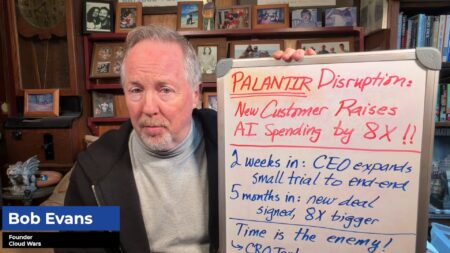How severe is the supply chain mess that’s snarling goods, transportation and customer orders across the global economy?
“However bad you think the supply chain situation is, it’s actually two times worse,” the CEO of an SAP customer recently told Julia White, Chief Marketing and Solutions Officer for the ERP giant. White related the story during her keynote at last week’s Cloud Wars Expo.
In retail, which has been among the hardest hit industries, some retailers are so eager to avoid dealing with returned merchandise that they’re considering refunding customers but not taking back the goods because of the cost of handling those returns. It’s been a nightmarish period for big retailers struggling with major inventory problems: Having loads of what customers don’t want and not enough of what they do want. The list reads as a retail who’s who: Target, Walmart, Macy’s and many more.
The retailers’ woes are bringing the fragility of supply chains and forecasting into sharp relief, but the problems aren’t unique to retail. They likely seem uniquely acute, however, in a market where they’re so visible: We still can’t seem to buy a lot of the consumer goods we want or need.

“Supply chains are outdated. They’re slow and fragile. They’re expensive and carbon intensive. Someone mis-parks their boat in the Suez Canal and all our shipments get delayed.”
Alaina Piland, CFO of Ivaldi.
In discussions with a number of experts, a few culprits for fragile supply chains came up repeatedly: creaky systems, opaque (and quickly shifting) customer preferences, and planning processes and systems that aren’t working.
“Supply chains are outdated. They’re slow and fragile. They’re expensive and carbon-intensive. Someone mis-parks their boat in the Suez Canal and all our shipments get delayed,” says Alaina Piland, CFO of the supply chain startup Ivaldi, which aims to make spare-parts manufacturing work more effectively.
What’s Broken in Supply Chains
The core problem that is snarling supply chains for retailers and others: unpredictability in demand and the resulting lack of visibility, or inability to plan for demand that companies can’t see.
“There’s very little that forecastable and predictable right now,” says Divya Krishnan, director of product marketing (and a supply chain expert) with Celonis, a supplier of execution management and processing mining software. “A lot of folks are just scrambling to figure out on a day-to-day, week-to-week basis, how to assess and best meet demand.”
Since the onset of Covid, the changes have come fast and furious. A case in point was delivered last week at Cloud Wars Expo by Goya Foods’ CIO, Suvajit Basu, who said that at the onset of Covid, the company went through four months worth of supply in a matter of days.
Krishnan says: “For most companies, the confluence of events we’re seeing hasn’t happened any time like this recently. A major clothing retailer described inflation to me as a second pandemic, coming on the heels of a pandemic that hasn’t actually left yet.”
One way companies are responding: adding inventory. “In today’s environment, we’re moving from just-in-time supply chains to just-in-case supply chains, which means companies are carrying more inventory,” says Ed Abbo, president and CTO of the AI and supply chain software supplier C3 AI. Those companies are also evaluating multi-sourcing, or using alternative suppliers of parts to make supply chains more resilient, Abbo says.
“A major clothing retailer described inflation to me as a second pandemic, coming on the heels of a pandemic that hasn’t actually left yet.”
Divya Krishnan, Celonis

A big part of the problem is that most systems that companies are using today (CRM, ERP, inventory planning) are primarily focused on looking back at what already happened, which means they’re far less helpful when it comes to anticipating or even reacting quickly to shifts in demand. “They don’t take into account uncertainties in demand and supply,” Abbo says.
Supply Chain Solutions
The biggest needs, experts agree, are to add resiliency to supply chains so they can more readily and nimbly adapt to shifting customer requirements and expectations, and to enable visibility in real time or close to real time.
My analysis found (at least) five concrete measures that can be applied to create greater visibility, and therefore greater controls and performance, to fix today’s broken supply chains.
1. Technology Solutions: AI, Automation, Cloud Computing
AI, and automation more broadly, is key to improving visibility and getting more of a predictive or forward-looking view into customer demand and preferences.
To that end, C3 AI is working with Google Cloud to unify C3 AI’s supply chain suite of applications with Google Cloud services and related products including Supply Chain Twin and Vertex AI, which lets customers configure and extend AI algorithms.
The partnership should improve visibility and forecasting accuracy. “You’re training the AI/ML models to characterize the demand for product, and in which locations, more accurately and precisely,” Abbo says. The AI/ML models are used to analyze orders coming in, orders by location, supply network risks regarding suppliers and the parts or materials they’re delivering, defect rates, shipping issues and more.
The end goals of looking at all these data streams:
- Accurate demand forecasts that enable companies to maximize fill rates and delivery of orders/products to customers
- Inventory optimization, so companies can accurately anticipate parts or materials needed based on demand forecasts and supply network risks
Kenny Mullican, CIO of the manufacturing firm Paragon Films and an Acceleration Economy analyst, said anytime you can apply automation to a manual process, supply chain efficiency will improve. “Any automated processes that can smooth that out can result in big improvements in getting products to stores or getting raw materials to factories quicker.”
AI must be combined with cloud computing to effect optimal outcomes. Berkeley Haas professor Luyi Yang, speaking at last week’s Cloud Wars Expo event, said more accurate demand forecasting requires highly scalable computing resources – which are only available in the cloud. “If you have all the data stored locally, you probably won’t have all the computing resources to actually run those sophisticated AI/ML and data mining models,” Yang said. “Cloud computing can facilitate information sharing between different parties along the supply chain.”

“If you have all the data stored locally, you probably won’t have all the computing resources to actually run those sophisticated AI/ML and data mining models.”
Berkeley Haas Professor Luyi Yang
2. More, and More Timely, Data
As noted above, a company’s existing ERP, CRM, inventory management, and other systems are clearly not adequate to keep things running smoothly in times that are this challenging. They’re not providing enough, or timely enough, data to keep a company filling orders in a way that is responsive to customer needs.
What’s needed is an additional layer that can pull data from all of a company’s existing systems, add in external data, and synthesize it for a cohesive view that delivers timely intelligence.
C3 AI’s Abbo argues, persuasively, that lots of other data points, and sources, should be pulled into the analysis, and inform the thinking, to make supply chains run more smoothly. C3 puts this in the category of ‘exogenous’ data such as weather, commodity prices, equity prices, industry indexes, and more — and its partnership with Google is making that possible.
“In today’s environment, we’re moving from just-in-time supply chains to just-in-case supply chains, which means companies are carrying more inventory.”
Ed Abbo, president and CTO, C3 AI

Such data also contribute to timeliness – by definition most of the exogenous examples listed above are going to be real time – such that decisions and adaptations can be made much more quickly.
“We’re using orders of magnitude more data to inform decisions,” Abbo says. “We’re aggregating data within a company (pricing, CRM, ERP) while also ingesting and aggregating exogenous data that plays a bigger factor in characterizing demand and supply…You would see the changes in demand happen sooner and be able to react to them.”
Other companies, including the startup NWO.ai, pulls in third party data and aggregates it for better views of customer trends for CPG firms.
3. Pinpoint Where the Process Is Breaking Down
Systems aren’t working as their customers need them to, but very likely their processes aren’t working as needed either. Enter those tools and technologies that delve into business processes and identify where they’re not working.
It’s not uncommon for corporate systems to reflect lead times for certain materials in master data sources (SAP, Oracle, or other ERP systems) that are inaccurate or don’t reflect the reality of how suppliers are actually delivering. A contract might be outdated, or perhaps the actual delivery lead time has never been accurately reflected. If delivery of a critical part is scheduled in a system to occur in five days, but it routinely takes seven or eight, process mining can automatically update that planning parameter and issue purchase orders with the correct timeframe. “So on both sides, the supplier isn’t scrambling and isn’t having to expedite, and the customer can plan more accurately and not have to delay a product,” says Celonis’ Krishnan.
The solution that Krishnan describes brings together process mining, execution management, and predictive analytics functions.
4. Migrate from Supply Chains to Supply Webs
Many of the supply chains that have negatively impacted companies in the past two years have relied on the practice of shifting labor work to low-cost regions of the world. That saved money but ignored the risks and costs of geopolitical instability, skyrocketing shipping costs, and other factors.
A better approach for today is a supply web, which Acceleration Economy analyst Wayne Sadin describes as: a larger number of on-shore, near-shore, and friend-shore suppliers feeding smaller order quantities to a larger number of geographically dispersed distribution hubs.
Berkeley Haas’ Yang similarly advocated taking a supply network perspective, as opposed to a supply chain perspective, by building in additional suppliers and reducing reliance on single suppliers.
5. Find Ways to Innovate
This analysis would be remiss if it didn’t include the potential for leveraging innovative technology from startups to augment current systems and bolster supply chains. Four such startups demonstrated products to enhance supply chains at Cloud Wars Expo. The companies and their technology approaches:
Specright: digitizes product and packaging specifications for better, more accurate, and efficient supply chain interactions.
Verusen: optimizes materials management processes to save costs, in part by eliminating redundant purchases
Ivaldi: maintains digital inventory so that spare parts can be manufactured on demand, rather than absorbing the costs of maintaining and transporting inventory
NWO: develops an AI and NLP platform that gathers and crunches vast quantities of data from publicly available sources, enabling customers like CPG firms to query that data for visibility into current and future customer trends.
Closing Thoughts: Need to Collaborate
Some of the companies interviewed for this analysis operate, or promote, collaborative supply chain networks or encourage supply chain partners to share their cloud-based apps. The idea is to share data, bring together companies within an industry, and fuel collaboration that drives efficiency and resiliency.

Collaboration, such as that exemplified by the SAP Business Network (which is supporting trillions in transactions), will help improve supply chain performance.
SAP Chief Marketing and Solutions Officer Julia White
One example came from SAP’s White: the SAP Business Network – which she describes as a LinkedIn for B2B suppliers and buyers to come together and solve problems. It’s transacting $3T per year. That’s a lot of transactions, a lot of technology, and a lot of collaboration.
We’re not going to get out of this mess without those three elements – and a whole lot more.









